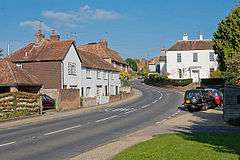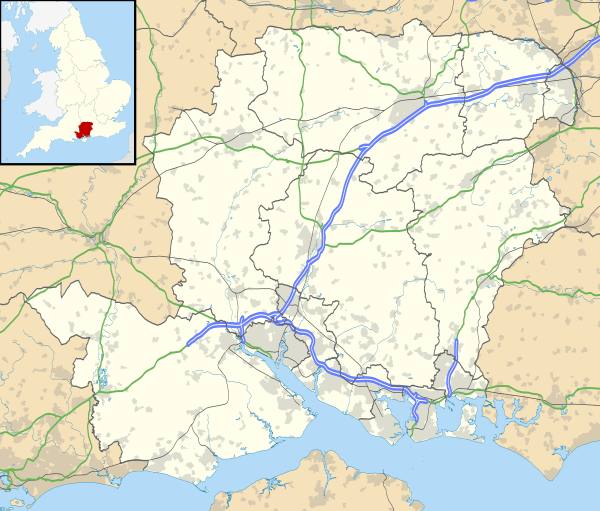Droxford
| Droxford | |
|---|---|
 High Street | |
 The local church is medieval and dedicated to All Saints and St Mary | |
 Droxford Droxford shown within Hampshire | |
| Population |
600 [1] 675 (2011 Census)[2] |
| OS grid reference | SU 60738 18662 |
| District | |
| Shire county | |
| Region | |
| Country | England |
| Sovereign state | United Kingdom |
| Post town | SOUTHAMPTON |
| Postcode district | SO32 |
| Dialling code | 01489 |
| Police | Hampshire |
| Fire | Hampshire |
| Ambulance | South Central |
| EU Parliament | South East England |
| UK Parliament | |
Droxford (arch. Drokensford) is a village in Hampshire, England.
Geography
The village is clustered with slight ribbon development along its main, north-south, undulating road. It is entirely on the lower half of the western slopes of the Meon valley. Farms and residential outbuildings stretch to the west, north and south. It is centred around its restored mainly 13th- and 14th-century church with a 1599-built tower together listed in the highest category for heritage,[3] being 3.5 miles (5.6 km) east of the nearest town Bishop's Waltham.
It is toward the centre-west of the South Downs National Park which was upgraded and expanded from a smaller AONB within which it sat in 2011. The non-dualled, non-trunk A32 passes through the village between Gosport and Alton which is largely bypassed by two motorways in the national network known as the A3 and M3. Its nearby railway has been mainly re-absorbed into fields and gardens but its converted railway station remains, a short walk from the water meadows of the village.
Amenities
The village has a convergence of national long-distance footpaths, a number of holiday lets and bed-and-breakfast establishments, a post office, two refuelling garages, two pubs and a village hall. Neighbouring isolated Shirrell Heath commands a view of the Hamble and Meon valleys, with the often "blue" hills of the Isle of Wight on the horizon.[4]
History
Droxford is very early recorded when its manor, the Manor of Drocenesforda was granted to the Prior and monks of St. Swithun, Winchester, by King Egbert in 826. In 939 king Æthelstan granted 17 hides of land at Droxford to his half-sister Eadburh.[5] By the time of the Domesday Survey Droxford which included much of Swanmore (the name of one of its tythings) and Shedfield[4] had passed to the Bishop of Winchester, to support the monks. This arrangement continued until 1551 when it was surrendered to the crown. It was passed on to the Earl of Wiltshire.
The Bishopric regained the manor in 1558, holding it until the Civil War. During the rule of Parliament the manor was transferred into private hands but on the Restoration of King Charles II in 1660 it was restored to the Bishopric.[4]
This situation continued until 1869 when the manor (amounting to a lessened, mid-19th-century, wealth and control of land management in the parish) was removed from the Bishopric as part of the Bishops' Resignation Act of 1869, and the area of the parish glebe (church lands) had also been substantially reduced by this time.[4] A Primitive Methodist church or chapel was built in 1886.
A railway came to serve Droxford in 1903 across the river in the neighbouring more rural parish with the building of the Meon Valley Railway. A station. A sub-settlement grew around the station including a hotel, railway workers' cottages and a cluster of private homes which extended to the north to the Brock Bridge or Brockbridge farm and mill which remains its name.
In June 1944 Allied leaders including Winston Churchill, Dwight Eisenhower, and Charles de Gaulle met in a train carriage at Droxford station to discuss the imminent D-Day invasion. There is a bench in the village to commemorate this meeting of world leaders in Droxford. British Railways closed the railway in 1962.
Church and landowner poverty relief
Aside from its state-incepted poor rate relief, the parish had minor legacies since the late 17th century and medium legacies relative to its small population since the 1850s for its poorest residents.
John Arthur, by will 1722, endowed for the poor of "the tithings of Droxford and Hill" £30; John Dee, by will 1749, gave for the local poor £50 (equivalent to £7,000 in 2016); and the Rev. James Cutler, formerly rector of the parish, by will 1782, left £50. These sums, with accumulated interest, were laid out in the purchase of £215 1⁄20 "consols" (consolidated investments), by 1905 held by the official trustees, the dividends, amounting to £5 11⁄30 a year being applied with the similar-size Boucher charity.[4]
In 1850 James George Boucher, by will, bequeathed to the rector and churchwardens a sum by 1905 growing to £190 18s. 7d. consols, with the official trustees, for the benefit of the poor of the parish. The dividends, amounting to £4 23⁄30.[4]
These dividends were for example in 1905 distributed thus: to the vicar of Shedfield £4..., to the vicar of Swanmore £3..., to be distributed in those districts, and £2 13s. 6d. was given in money to ten poor people in Droxford (i.e. £2 27⁄40, equivalent to £260 in 2016).[4]
By Inclosure Award of 9 May, 1855, two allotments of 4 acres each were allotted for the use of the poor of Shedfield, the rents of which, amounting to about £25 a year, were still in 1905 applied for public uses, subject, however, to yearly rent-charges. Under the same award 5 acres was allotted as a recreation ground. By deed of 1880 a site and buildings were given at minimal value for the purpose of reading and recreation rooms.[4]
References
- ↑ Census data
- ↑ "Civil Parish population 2011". Neighbourhood Statistics. Office for National Statistics. Retrieved 14 December 2016.
- ↑ Historic England. "Details from listed building database (1095540)". National Heritage List for England.
- 1 2 3 4 5 6 7 8 http://www.british-history.ac.uk/vch/hants/vol3/pp284-288
- ↑ Sawyer no. 446
External links
| Wikimedia Commons has media related to Droxford. |
